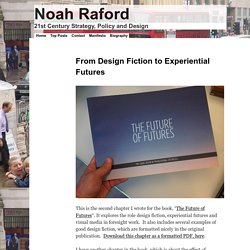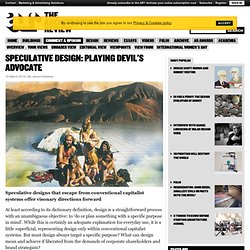

'My radio prefers bacon' From Design Fiction to Experiential Futures. This is the second chapter I wrote for the book, “The Future of Futures“.

It explores the role design fiction, experiential futures and visual media in foresight work. It also includes several examples of good design fiction, which are formatted nicely in the original publication. Download this chapter as a formatted PDF, here. I have another chapter in the book, which is about the effect of crowdsourcing, big data and the web on scenario planning and foresight. You can read it here. FCJ-142 Spectacles and Tropes: Speculative Design and Contemporary Food Cultures. Carl DiSalvoGeorgia Institute of Technology, Atlanta Abstract: Speculative design is a particularly inventive mode of design that is concerned with developing imaginative futures or alternate presents.

Often, the purpose of speculative design is to prompt reflection on contemporary conditions and express possible implications of current trends in science and technology. Like all design, speculative design reproduces as well as invents culture and there are limits to the work it does. In this essay, I trace the ways speculative design reproduces contemporary food cultures through two projects: Guide to Free Farming (2009) and Family Whiskey (2010). About. We work closely with clients and collaborators on projects that acknowledge the reality of our rapidly changing times, designing with and for uncertainty, instead of resisting it.

We are particularly interested in the ways emerging technologies interface with the environment and everyday life, and with proven experience in design, strategy and foresight, Superflux is in a unique position to explore the implications of these new interactions. Ultimately, we strive to embed these explorations in the here-and-now -- using rapid prototyping and media sketches to turn them into stimulating concepts, experiences, products and services. Our business has two parts. The consultancy is client-facing, offering bespoke services, while the lab is a research space where we develop and test new ideas. Though these two parts function independently, we've come to rely on their contrasting rhythms for team sanity, the 'sweet spot' of unexpected synergies, and a steady stream of new ideas and provocations.
Speculative fiction. History[edit] In mythography the concept of speculative fiction has been termed "mythopoesis" or mythopoeia, "fictional speculation", the creative design and generation of lore, regarding such works as J.R.R.

Tolkien's The Lord of the Rings.[9] Such supernatural, alternate history and sexuality themes continue in works produced within the modern speculative fiction genre.[10] The creation of speculative fiction in its general sense of hypothetical history, explanation, or ahistorical storytelling has also been attributed to authors in ostensibly non-fiction mode since as early as Herodotus of Halicarnassus, (fl. 5th century BCE) in his Histories,[11][12][13] and was already both practiced and edited out by early encyclopaedic writers like Sima Qian (ca. 145 or 135 BCE–86 BCE), author of Shiji.[14][15] In its English language usage in arts and literature since 20th century, "speculative fiction" as a genre term is often attributed to Robert A. Heinlein. See also[edit] History Genres Themes.
Speculative Design: Playing Devil's Advocate. Speculative designs that escape from conventional capitalist systems offer visonary directions forward At least according to its dictionary definition, design is a straightforward process with an unambiguous objective: to ‘do or plan something with a specific purpose in mind’.

While this is certainly an adequate explanation for everyday use, it is a little superficial, representing design only within conventional capitalist systems. But must design always target a specific purpose? What can design mean and achieve if liberated from the demands of corporate shareholders and brand strategists? Since the 1960s, a number of irreverent ‘speculative designers’ have explored the potential of such emancipated practice. Clive Sinclair in his C5 tricycle, which was voted one of the ‘biggest innovation disasters’ of all time Consider the example of British designer Clive Sinclair’s infamous C5: a flopped concept for a battery-assisted personal urban tricycle (how much more radical does it get?). Speculative Fiction, Speculative Design.
England Swings SF, Doubleday, 1968 I had barely walked into Out of This World: Science Fiction But Not As You Know It, an exhibition at the British Library in London, when I noticed a book cover that blew me away.

I present it here for your enjoyment, or perhaps your dismissal. Never having seen this strange dust jacket before, I immediately wanted to know who designed it. England Swings SF, Judith Merril’s collection of “speculative fiction” by writers from SF’s “British” new wave, was published in 1968 by Doubleday in New York. But there is no information about the cover’s creator in the exhibition (the curators focus on the authors) and when I googled the collection later, I could find only two images of the book. I’ll come back to the designer, but let’s treat the England Swings SF cover as the work of “anonymous” for a few moments longer. Mattias Ludvigsson - User Experience Designer.